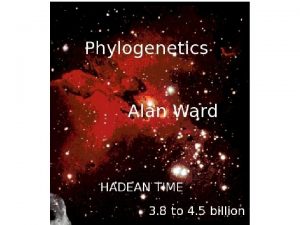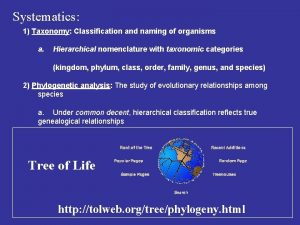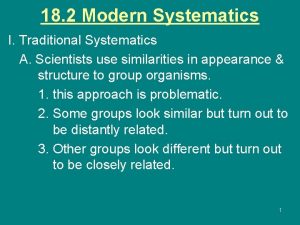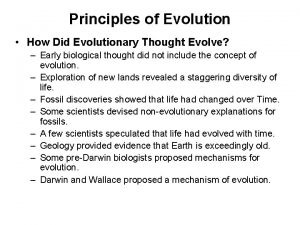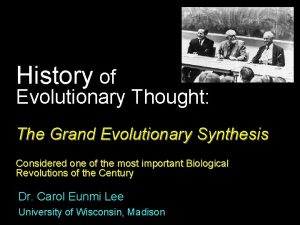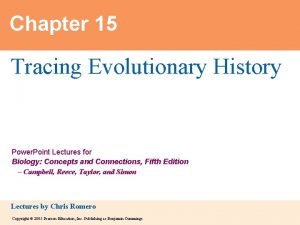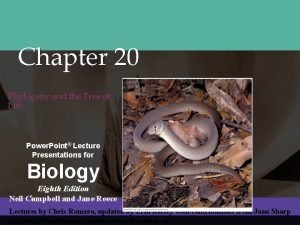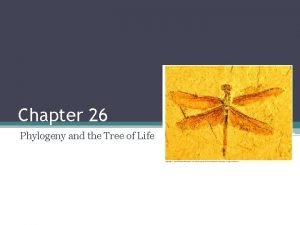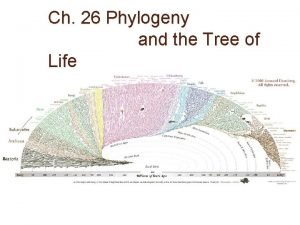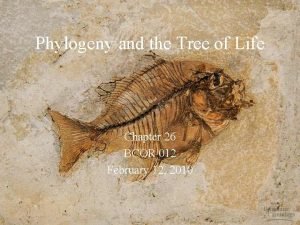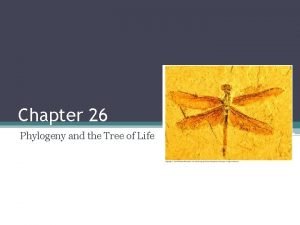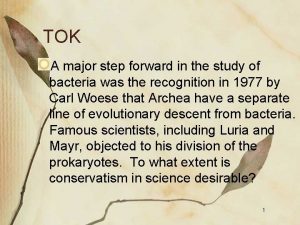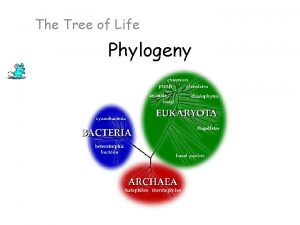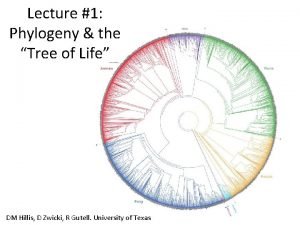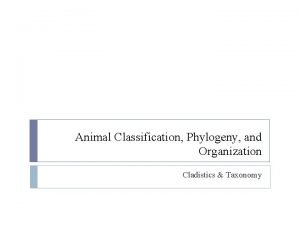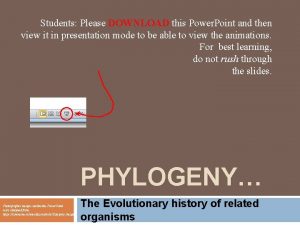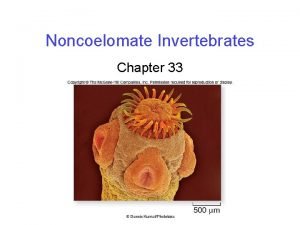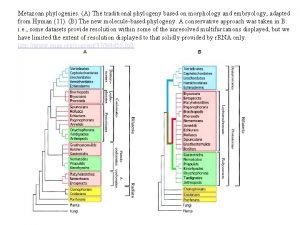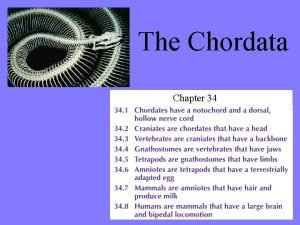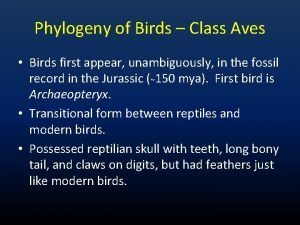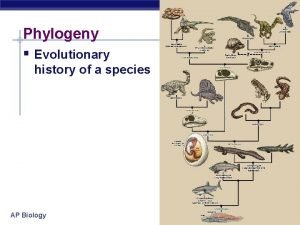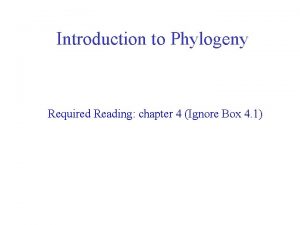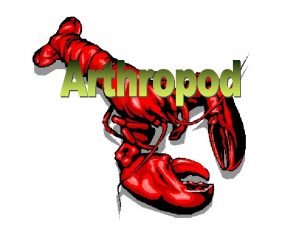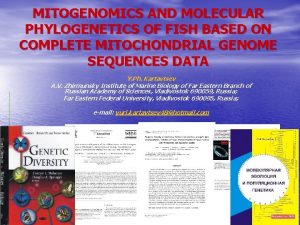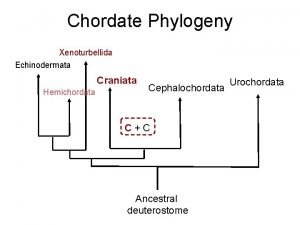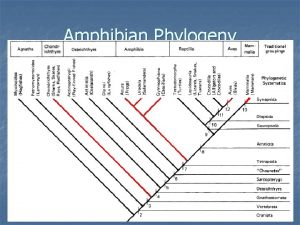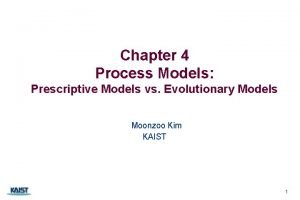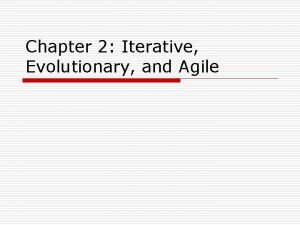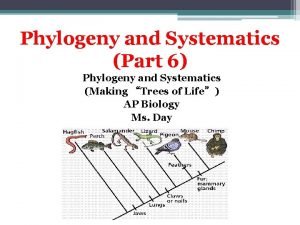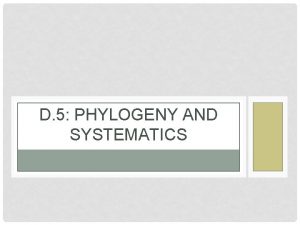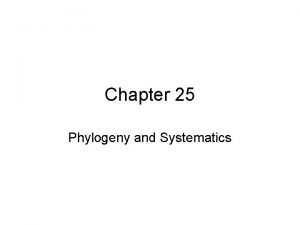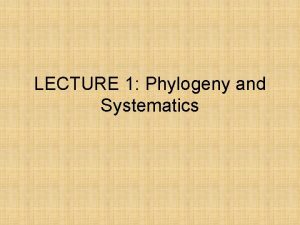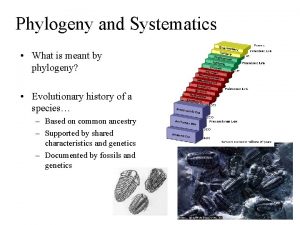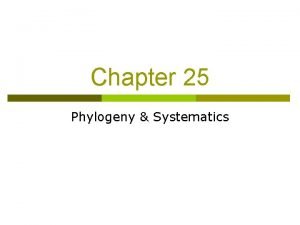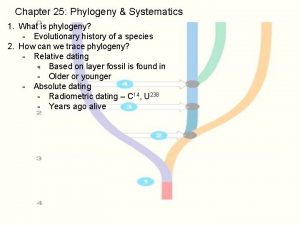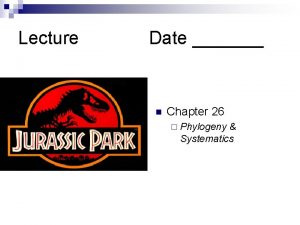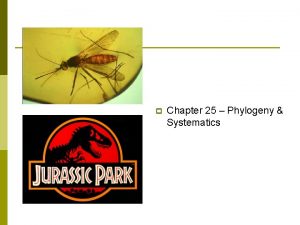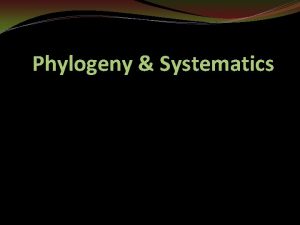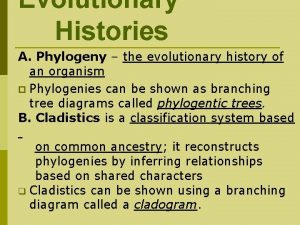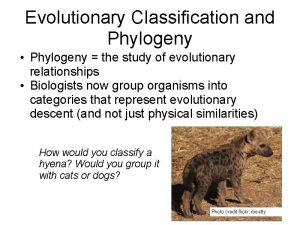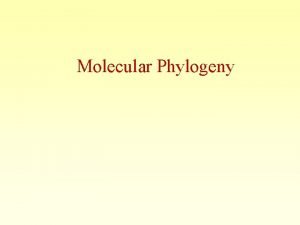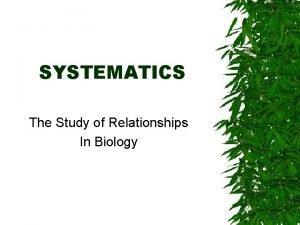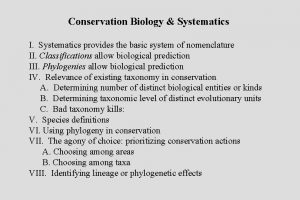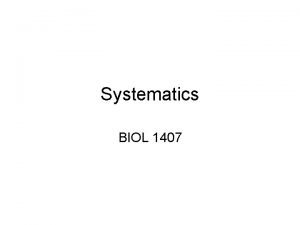Phylogeny and Systematics Phylogeny is the evolutionary history






















































































- Slides: 86

Phylogeny and Systematics • Phylogeny is the evolutionary history of a group of organisms

Phylogeny and Systematics • Phylogeny is the evolutionary history of a group of organisms which species are ancestral to which others…

Phylogeny and Systematics • Phylogeny is the evolutionary history of a group of organisms • Systematics is the science of reconstructing the evolutionary history of a group of organisms

Phylogeny and Systematics • in order to understand phylogeny through the science of systematics, we must start at the beginning - macroevolution starts with the origin of species

Phylogeny and Systematics • Speciation - ? ? ?

Phylogeny and Systematics • Speciation - the evolution of reproductive isolation between onceinterbreeding populations • The evolutionary source of new species through adaptive evolution

Phylogeny and Systematics • Speciation - the evolution of reproductive isolation between onceinterbreeding populations • The evolutionary source of new species through adaptive evolution • Taxonomy - the naming of species

Phylogeny and Systematics • Speciation - the evolution of reproductive isolation between onceinterbreeding populations • Taxonomy - the naming of species • “New species” implies that a species is newly described by taxonomists, not that it • The evolutionary source of has newly diverged new species through from its ancestor adaptive evolution

Phylogeny and Systematics • Speciation - the evolution of • Taxonomy - the reproductive isolation between naming of species once-interbreeding populations • The evolutionary source of new species through adaptive evolution • We don’t know how many species exist - taxonomists have lots to do

Phylogeny and Systematics • Speciation - the evolution of • Taxonomy - the reproductive isolation between naming of species once-interbreeding populations • Taxonomy uses • The evolutionary source of “binomial new species through adaptive nomenclature” which evolution means naming species • We don’t know how many with two names species exist - taxonomists have lots to do Genus species • for instance…

Phylogeny and Systematics descendant species taxonomists describe species speciation time ancestral species phenotypic divergence Newly-evolved species to diverge from one another in a variety of characteristics, not just those that affect RI

Phylogeny and Systematics descendant species speciation time Ancestral species phenotypic divergence Phylogenetically closely related species diverge in characteristics over evolutionary time because they occupy different environments - this is “divergent evolution”

Phylogeny and Systematics derived, descendant species now then Ancestral species A series of speciation events over evolutionary time that leads from a single ancestral species to a set of derived, descendant species is “adaptive radiation”

Phylogeny and Systematics • Adaptive radiation - A series of speciation events over evolutionary time that leads from a single ancestral species to a set of derived, descendant species • Divergent evolution - phylogenetically closely related species in different environments develop different phenotypic characteristics due to different environmental selection pressures

Phylogeny and Systematics derived, descendant species now then Taxonomists describe species - they work with what we have now Systematists sort species into categories - they try to figure out what happened in the past Ancestral species

Phylogeny and Systematics the problem for systematists is time….

Phylogeny and Systematics • Phylogeny is the study of phenomena that happened in the past, sometimes deep in the past

Phylogeny and Systematics • Phylogeny is the study of phenomena that happened in the past, sometimes deep in the past • Life on earth originated about 3. 5 billion years ago

Phylogeny and Systematics • Phylogeny is the study of phenomena that happened in the past, sometimes deep in the past • Life on earth originated about 3. 5 billion years ago • vertebrates originated about 500 million years ago

Phylogeny and Systematics • Phylogeny is the study of phenomena that happened in the past, sometimes deep in the past • Life on earth originated about 3. 5 billion years ago • vertebrates originated about 500 million years ago • How can we understand this history?

Phylogeny and Systematics • Phylogeny is the study of phenomena that happened in the past, sometimes deep in the past • Life on earth originated about 3. 5 billion years ago • vertebrates originated about 500 million years ago • What are our historical texts? ?

Phylogeny and Systematics • Direct evidence - the fossil record

Phylogeny and Systematics • Direct evidence - the fossil record • Paleontology



Phylogeny and Systematics • Direct evidence - the fossil record • Indirect evidence • Paleontology

Phylogeny and Systematics • Direct evidence - the fossil record • Indirect evidence • anatomical homology • Paleontology

Phylogeny and Systematics • Direct evidence - the fossil record • Indirect evidence • anatomical homology • Paleontology • comparative anatomy

Phylogeny and Systematics

Phylogeny and Systematics • Direct evidence - the fossil record • Indirect evidence • anatomical homology • embryonic homology • Paleontology • comparative anatomy • comparative embryology

Phylogeny and Systematics

Phylogeny and Systematics • Direct evidence - the fossil record • Indirect evidence • anatomical homology • embryonic homology • molecular homology • Paleontology • comparative anatomy • comparative embryology • molecular systematics

Phylogeny and Systematics

Phylogeny and Systematics • How do systematists make decisions about phylogeny?

Phylogeny and Systematics • How do systematists make decisions about phylogeny? • Systematists compare characteristics of species whose phylogenetic relationships they are trying to determine

Phylogeny and Systematics • How do systematists make decisions about phylogeny? • Comparisons of characteristics… • “ancestral” and “derived” are relative states

Phylogeny and Systematics • How do systematists make decisions about phylogeny? • Comparisons of characteristics… • “ancestral” and “derived” are relative states • phylogenetic relationships are determined by shared derived characteristics

Phylogeny and Systematics • Phylogenetic relationships are determined by shared derived characteristics • Think back to our discussion of mammals…

Phylogeny and Systematics • Phylogenetic relationships are determined by shared derived characteristics • Think back to our discussion of mammals… • Mammals share – hair – mammary glands – three “ear ossicles” – other derived characteristics

Phylogeny and Systematics • Phylogenetic relationships are determined by shared derived characteristics • Mammals share – – hair mammary glands three “ear ossicles” other derived characteristics • these shared derived characteristics distinguish mammals from other groups of vertebrates

Phylogeny and Systematics • Derived characteristics are called “apomorphic” characteristics or “apomorphies”

Phylogeny and Systematics • Derived characteristics are called “apomorphic” characteristics or “apomorphies” • An apomorphy of humans is upright posture

Phylogeny and Systematics • Derived characteristics are called “apomorphic” characteristics or “apomorphies” • Derived characteristics that are shared by two or more species in a group of species are called “synapomorphies”

Phylogeny and Systematics • Derived characteristics are called “apomorphic” characteristics or “apomorphies” • Derived characteristics that are shared by two or more species in a group of species are called “synapomorphies” • Eyesockets (orbits) on the front of the skull is a synapomorphy of primates

Phylogeny and Systematics • Derived characteristics are called “apomorphic” characteristics or “apomorphies” • Derived characteristics that are shared by two or more species in a group of species are called “synapomorphies” • The shared derived characteristics that distinguish a group of organisms from other groups are their “unifying synapomorphies”

Phylogeny and Systematics • The shared derived characteristics that distinguish a group of organisms from other groups are their “unifying synapomorphies” • The unifying synapomorphies of mammals include…

Phylogeny and Systematics • Remember that “ancestral” and “derived” are relative terms

Phylogeny and Systematics • Remember that “ancestral” and “derived” are relative terms • The unifying synapomorphies of mammals are derived relative to other vertebrate groups

Phylogeny and Systematics • Remember that “ancestral” and “derived” are relative terms • The unifying synapomorphies of mammals are derived relative to other vertebrate groups • But the original or ancestral mammal had these characteristics

Phylogeny and Systematics • Remember that “ancestral” and “derived” are relative terms • The unifying synapomorphies of mammals are derived relative to other vertebrate groups • But the original or ancestral mammal had these characteristics • So within mammals those characteristics are ancestral

Phylogeny and Systematics • Remember that “ancestral” and “derived” are relative terms • The unifying synapomorphies of mammals are derived relative to other vertebrate groups • But the original or ancestral mammal had these characteristics • So within mammals those characteristics are ancestral • Do these shared ancestral characteristics tell us anything about phylogenetic relationships within mammals?

Phylogeny and Systematics • Ancestral characteristics are called “plesiomorphic” characteristics or “plesiomorphies”

Phylogeny and Systematics • Ancestral characteristics are called “plesiomorphic” characteristics or “plesiomorphies” • Shared ancestral characteristics are called “symplesiomorphies”

Phylogeny and Systematics • Ancestral characteristics are called “plesiomorphic” characteristics or “plesiomorphies” • Shared ancestral characteristics are called “symplesiomorphies” • Symplesiomorphies tell us nothing about phylogenetic relationships within groups of species…

Phylogeny and Systematics • Symplesiomorphies tell us nothing about phylogenetic relationships within groups of species… • because all species in a group share them

Phylogeny and Systematics another example… Collared lizard, Crotaphytus collaris Black rat snake, Elaphe obsoleta

Phylogeny and Systematics • Lizards and snakes are classified together in the Class Reptilia, Order Lepidosauria (the scaly reptiles) • They are distinguished from other reptiles (turtles and crocodilians) by scaly skin, paired copulatory organs, and a transverse cloacal opening (among other characteristics)

Phylogeny and Systematics • These are the unifying synapomorphies of the lepidosaurs • They do not tell us anything about relationships within the lepidosaurs

Phylogeny and Systematics • These are the unifying synapomorphies of the lepidosaurs • They do not tell us anything about relationships within the lepidosaurs • Snakes evolved from lizards; a particular group of lizards, the monitor lizards, is thought to be ancestral to the snakes.

Phylogeny and Systematics Komodo dragon, a monitor lizard

Phylogeny and Systematics • Snakes evolved from lizards. . . • How do we tell snakes from lizards?

Phylogeny and Systematics • How do we tell snakes from lizards? • Snakes have… – no legs (most lizards have legs) – a forked tongue (most lizards have a blunt tongue) – spectacles rather than eyelids

Phylogeny and Systematics • How do we tell snakes from lizards? • Snakes have… – no legs – a forked tongue – spectacles rather than eyelids • These are the unifying synapomorphies of snakes

Phylogeny and Systematics • How do we tell snakes from lizards? • Snakes have… – no legs – a forked tongue – spectacles rather than eyelids • These are the unifying synapomorphies of snakes • They are derived characteristics relative to the lizards, so allow systematists to distinguish between snakes and lizards

Phylogeny and Systematics derived lizards snakes ancestral lepidosaur derived lizards

Phylogeny and Systematics derived lizards we include lizards and snakes together in the group “lepidosaurs”; they share a common ancestor snakes ancestral lepidosaur derived lizards

Phylogeny and Systematics derived lizards snakes derived lizards we place all snakes in a group within the lepidosaurs, the “serpentes”, which also share a common ancestor we include lizards and snakes together in the group “lepidosaurs”; they share a common ancestor ancestral lepidosaur

Phylogeny and Systematics derived lizards snakes derived lizards we place all snakes in a group within the lepidosaurs, the “serpentes”, which also share a common ancestor we include lizards and snakes together in the group “lepidosaurs”; they share a common ancestor These are “monophyletic” taxa ancestral lepidosaur

Phylogeny and Systematics derived lizards snakes derived lizards Serpentes (the snakes) is a monophyletic taxon ancestral lepidosaur

Phylogeny and Systematics derived lizards Lepidosaurs (lizards and snakes combined) is a monophyletic taxon snakes derived lizards Serpentes (the snakes) is a monophyletic taxon ancestral lepidosaur

Phylogeny and Systematics derived lizards What about the lizards, excluding the snakes? We used to call this “Lacertilia” snakes ancestral lepidosaur derived lizards

Phylogeny and Systematics derived lizards What about the lizards, excluding the snakes? We used to call this “Lacertilia” snakes derived lizards The Lacertilia is a “paraphyletic” taxon ancestral lepidosaur

Phylogeny and Systematics snakes leg les sl iza rd s derived lizards what about legless lizards? ancestral lepidosaur derived lizards

Phylogeny and Systematics • Remember the process of divergent evolution - phylogenetically closely related species that occupy different environments evolve phenotypic differences due to different environmental selection pressures

Phylogeny and Systematics • What happens when phylogenetically distantly related species occupy similar environments?

Phylogeny and Systematics • What happens when phylogenetically distantly related species occupy similar environments? • They evolve phenotypic similarities due to similar environmental selection pressures.

Phylogeny and Systematics • Convergent evolution - phylogenetically distantly related species that occupy similar environments evolve phenotypic similarities due to similar environmental selection pressures.

Phylogeny and Systematics snakes derived lizards what about legless lizards? Legless lizards evolved leglessness convergently with snakes ancestral lepidosaur

Phylogeny and Systematics snakes derived lizards what about legless lizards? Convergent evolution can fool us into thinking a phylogenetic relationship exists when in fact it does not… Legless lizards evolved leglessness convergently with snakes ancestral lepidosaur

Phylogeny and Systematics derived lizards what about legless lizards? Convergent evolution can fool us into thinking a phylogenetic relationship exists when in fact it does not… ancestral lepidosaur A taxon that includes a species that is not descended from the ancestor of the other species in the taxon is called “polyphyletic”

Phylogeny and Systematics derived lizards what about legless lizards? Convergent evolution can fool us into thinking a phylogenetic relationship exists when in fact it does not… polyphyletic taxa propose phylogenetic relationships that do not exist ancestral lepidosaur A taxon that includes a species that is not descended from the ancestor of the other species in the taxon is called “polyphyletic”

Phylogeny and Systematics • Are there any actual examples of paraphyletic and polyphyletic taxa?

Phylogeny and Systematics utahraptor here croc here

Phylogeny and Systematics Reptilia a paraphyletic class because the birds are excluded

Phylogeny and Systematics Pongidae a paraphyletic family

Phylogeny and Systematics Arthropoda - a polyphyletic phylum?
 Systematics vs taxonomy
Systematics vs taxonomy 0110001101
0110001101 Traditional systematics
Traditional systematics Systematics deals with
Systematics deals with Modern systematics try to group organisms based on
Modern systematics try to group organisms based on History of evolutionary thought
History of evolutionary thought History of evolutionary thought
History of evolutionary thought Chapter 15 tracing evolutionary history
Chapter 15 tracing evolutionary history Evolutionary history
Evolutionary history Phylogeny
Phylogeny Chapter 20 phylogeny and the tree of life
Chapter 20 phylogeny and the tree of life Phylogeny and the tree of life chapter 26
Phylogeny and the tree of life chapter 26 Chapter 26 phylogeny and the tree of life
Chapter 26 phylogeny and the tree of life Chapter 26 phylogeny and the tree of life
Chapter 26 phylogeny and the tree of life Chapter 26 phylogeny and the tree of life
Chapter 26 phylogeny and the tree of life Phenogram and cladogram
Phenogram and cladogram Outgroup biology definition
Outgroup biology definition What is a sister group in phylogeny
What is a sister group in phylogeny Class pterobranchia
Class pterobranchia Crab cladogram
Crab cladogram Phylum evolutionary tree
Phylum evolutionary tree Taxa phylogenetic tree
Taxa phylogenetic tree Animal kingdom cladogram
Animal kingdom cladogram What is a mammal
What is a mammal Phylogeny
Phylogeny Monophyletic group
Monophyletic group Phylogeny of invertebrates
Phylogeny of invertebrates Bryozoa
Bryozoa Figure 34
Figure 34 Enantiornithes
Enantiornithes Cat family tree
Cat family tree Simple phylogeny ebi
Simple phylogeny ebi Artiodactyla phylogeny
Artiodactyla phylogeny Ontogeny recapitulates phylogeny
Ontogeny recapitulates phylogeny Arthropoda
Arthropoda Fish phylogeny
Fish phylogeny Craniata phylogeny
Craniata phylogeny Phylogeny is the study of _____.
Phylogeny is the study of _____. Lungfish vs spotted salamander
Lungfish vs spotted salamander Chapter 15 darwin's theory of evolution
Chapter 15 darwin's theory of evolution Prescriptive process models
Prescriptive process models Iterative and evolutionary development
Iterative and evolutionary development Conventional and evolutionary work breakdown structure
Conventional and evolutionary work breakdown structure Hình ảnh bộ gõ cơ thể búng tay
Hình ảnh bộ gõ cơ thể búng tay Frameset trong html5
Frameset trong html5 Bổ thể
Bổ thể Tỉ lệ cơ thể trẻ em
Tỉ lệ cơ thể trẻ em Voi kéo gỗ như thế nào
Voi kéo gỗ như thế nào Tư thế worm breton
Tư thế worm breton Alleluia hat len nguoi oi
Alleluia hat len nguoi oi Các môn thể thao bắt đầu bằng tiếng đua
Các môn thể thao bắt đầu bằng tiếng đua Thế nào là hệ số cao nhất
Thế nào là hệ số cao nhất Các châu lục và đại dương trên thế giới
Các châu lục và đại dương trên thế giới Công thức tính thế năng
Công thức tính thế năng Trời xanh đây là của chúng ta thể thơ
Trời xanh đây là của chúng ta thể thơ Mật thư anh em như thể tay chân
Mật thư anh em như thể tay chân Làm thế nào để 102-1=99
Làm thế nào để 102-1=99 Phản ứng thế ankan
Phản ứng thế ankan Các châu lục và đại dương trên thế giới
Các châu lục và đại dương trên thế giới Thơ thất ngôn tứ tuyệt đường luật
Thơ thất ngôn tứ tuyệt đường luật Quá trình desamine hóa có thể tạo ra
Quá trình desamine hóa có thể tạo ra Một số thể thơ truyền thống
Một số thể thơ truyền thống Cái miệng xinh xinh thế chỉ nói điều hay thôi
Cái miệng xinh xinh thế chỉ nói điều hay thôi Vẽ hình chiếu vuông góc của vật thể sau
Vẽ hình chiếu vuông góc của vật thể sau Nguyên nhân của sự mỏi cơ sinh 8
Nguyên nhân của sự mỏi cơ sinh 8 đặc điểm cơ thể của người tối cổ
đặc điểm cơ thể của người tối cổ Thế nào là giọng cùng tên
Thế nào là giọng cùng tên Vẽ hình chiếu đứng bằng cạnh của vật thể
Vẽ hình chiếu đứng bằng cạnh của vật thể Vẽ hình chiếu vuông góc của vật thể sau
Vẽ hình chiếu vuông góc của vật thể sau Thẻ vin
Thẻ vin đại từ thay thế
đại từ thay thế điện thế nghỉ
điện thế nghỉ Tư thế ngồi viết
Tư thế ngồi viết Diễn thế sinh thái là
Diễn thế sinh thái là Dạng đột biến một nhiễm là
Dạng đột biến một nhiễm là Bảng số nguyên tố lớn hơn 1000
Bảng số nguyên tố lớn hơn 1000 Tư thế ngồi viết
Tư thế ngồi viết Lời thề hippocrates
Lời thề hippocrates Thiếu nhi thế giới liên hoan
Thiếu nhi thế giới liên hoan ưu thế lai là gì
ưu thế lai là gì Sự nuôi và dạy con của hươu
Sự nuôi và dạy con của hươu Khi nào hổ con có thể sống độc lập
Khi nào hổ con có thể sống độc lập Hệ hô hấp
Hệ hô hấp Từ ngữ thể hiện lòng nhân hậu
Từ ngữ thể hiện lòng nhân hậu Thế nào là mạng điện lắp đặt kiểu nổi
Thế nào là mạng điện lắp đặt kiểu nổi Scientific psychology definition
Scientific psychology definition Vuzzer
Vuzzer
